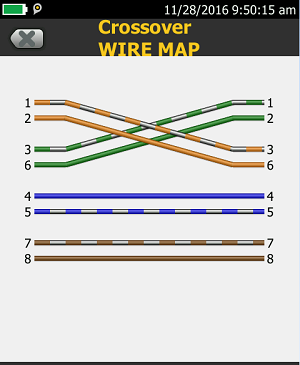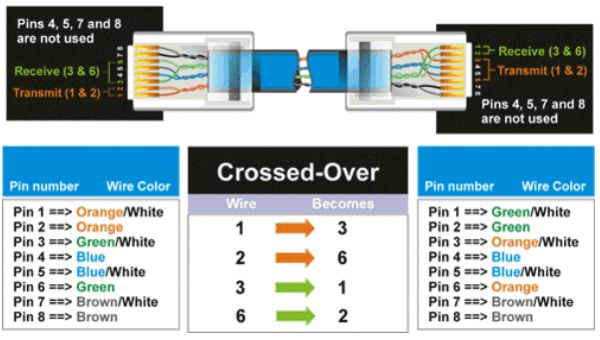

Specifically, pins 1, 2, 4, and 5 are connected to 4, 5, 1, and 2 respectively. A T1 cable uses T568B pairs 1 and 2, so to connect two T1 CSU/DSU devices back-to-back requires a crossover cable that swaps these pairs.Twisted pair Token Ring uses T568B pairs 1 and 3 (the same as T568A pairs 1 and 2), so a crossover cable to connect two Token Ring interfaces must swap these pairs, connecting pins 4, 5, 3, and 6 to 3, 6, 4, and 5 respectively.Some connection standards use different balanced pairs to transmit data, so crossover cables for them have different configurations to swap the transmit and receive pairs: A loopback is a type of degraded "one side crosslinked connection" connecting a port to itself, usually for test purposes.Using different wiring at each end yields a crossover cable (a given color wire connects to one number pin at one end, and a different number pin at the other). Such crossover cables are electrically symmetrical, meaning that they work identically regardless of which way you plug them in (if you turn the cable around, it still connects the same pins as before).

For example, if pin 1 on one end goes to pin 2 on the other end, then pin 2 on one end goes to pin 1 on the other end, and the other pins remain unaffected. In a crossover cable, pins do not correspond – some or all of the conductors are swapped at the terminations. In this case, the terminations are identical, so only one pinout is required. Using the same wiring scheme at each end yields a straight-through cable (a given color wire connects to a given number pin, the same at both ends). In a straight-through cable, pins on one end correspond exactly to the corresponding pins on the other end (pin 1 to pin 1, pin 2 to pin 2, etc.). Straight-through cables are used for most applications, but crossover cables are required in others. In contrast, a straight-through cable uses direct wiring to connect complementary devices, e.g. linking two or more hubs, switches or routers (DCE) together, possibly to work as one wider device.letting two terminal (DTE) devices communicate without an interconnecting hub knot, i.e.connecting two devices directly, output of one to input of the other,.The crossing of wires in a cable or in a connector adaptor allows: Such a distinction between devices was introduced by IBM. JSTOR ( February 2008) ( Learn how and when to remove this template message)Ī crossover cable connects two devices of the same type, for example DTE-DTE or DCE-DCE, usually connected asymmetrically (DTE-DCE), by a modified cable called a crosslink.

Unsourced material may be challenged and removed. Please help improve this article by adding citations to reliable sources. This article needs additional citations for verification.


 0 kommentar(er)
0 kommentar(er)
